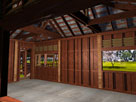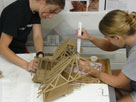| Construction of a Cambodian
land mine museum designed by Texas A&M University architecture students has moved a big step
closer to reality, thanks to high-level Canadian diplomatic negotiations
with the Cambodian government regarding land for the museum and
a letter-writing campaign spearheaded by the Aggies and the professor
in whose class they developed the plans for a museum memorializing
victims of the infamous Khmer Rouge “killing fields.”
The letter campaign brought attention to problems the Cambodian
Land Mine Museum Relief Fund (CLMMRF) encountered with the Cambodian
government after purchasing a site for the new museum near the
Siem Reap Airport, in a location undergoing rapid development.
Later, that same year, the Cambodian government barred the museum’s
construction on the proposed site. Through their letter writing
campaign, the Texas A&M students garnered support for the
museum project from several prominent politicians, diplomats
and world-renown celebrities.
The efforts paid off. In May, Cambodian government agreed to
a land swap, trading the original museum site for a parcel of
land nearly twice the size. The new site, located in a rural
area about 15 kilometers from Siem Reap, promises to be highly
visible to tourists. It sits on the route to the 10th century
temple of Banteay Srei and several other ruins that make up the
World Heritage Site of the Angkor Wat Archeological Park.
Rogers, who holds a Ph.D. in architecture and has a special
interest in Southeast Asian art and architecture, got her students
involved with the project three years ago, when they developed
designs for the proposed museum. The designs were unveiled September
2003 to representatives of the Cambodian Land Mine Museum Relief
Fund, and one design was chosen to be further articulated for
construction. The Texas A&M students also helped raise funds
for the museum’s construction, staging a March 2004 fun
run and selling student-designed Land Mine Museum T-shirts.
“Today numerous students are witnessing a dream on paper
come close to being a reality,” said Rogers. “It
is fitting that we are scheduled to begin construction, as the
students who began the project three years ago graduated only
last month. I am extremely grateful not only for the talent of
these students, but also for their motivation and perseverance,” she
continued. “This grassroots project demonstrates the ability
our students have to bring about change on a global basis.”
The original land mine museum is owned and operated by Aki Ra,
a former child-soldier who participated in the laying of land
mines in his youth and has since devoted his life to removing
the estimated 6 million mines still hidden in the Cambodian soil.
Since 1999, Ra has cleared more than 6,000 land mines with little
more than a wrench and a hammer. His incredible collection of
mine shells and bomb casings are on display at the museum along
with archives chronicling the rise and fall of the Khmer Rouge
and the genocidal horrors of Cambodia's infamous “Killing
Fields.”
The new facility will house the existing land mine exhibits
created by Ra, and will provide exhibition space for Ra’s
paintings chronicling the hardships of war. An education space
will support prevention through awareness. Additionally, rehabilitation
facilities will provide prosthetic assistance to victims of land
mines.
The student’s original designs are currently being updated
to utilize more affordable and available local materials.
“We are aware that Cambodia’s environment is in
danger of deforestation, and in response to this crisis we are
utilizing more brick, concrete, and tile,” wrote CLMMRF
founder Richard Fitoussi, in the June 2006 CLMMRF newsletter
that announced the land swap agreement. “This material
change will in a small way respond to the growing problem of
deforestation in Cambodia. In addition, these materials will
require less long term maintenance.”
Fitoussi said the CLMMRF would not have been able to realize
the new facility without the hard work and dedication of Rogers
and her students.
“Dr. Rogers was responsible for mobilizing an incredible
letter-writing campaign to help lobby our case in Cambodia,” he
wrote. “Her team of student architects from Texas A&M
University’s College of Architecture worked to secure very
important endorsements for the CLMMRF from several prominent
figures including the U.S. Ambassador to Cambodia, several U.S.
Senators, members of the U.S. State Department, the office of
Paul and Heather McCartney, and Hollywood Director Tom Shadyac,
to name but a few. The CLMMRF would like to personally thank
her for her dedication to this project,” Fitoussi continued. “We
would also like to thank her team for creating the Land Mine
Museum facility that will soon be built.”
In addition to recognizing the extraordinary contributions of
Rogers and her students toward realizing the new museum facility,
Fitoussi thanked Canadian Ambassador Donica Pottie, “who
worked diligently to overcome numerous diplomatic obstacles,” and
Canadian Prime Minister Paul Martin, “for his personal
endorsement of the project and for encouraging the Cambodian
government to reach this settlement agreement.”
| 





